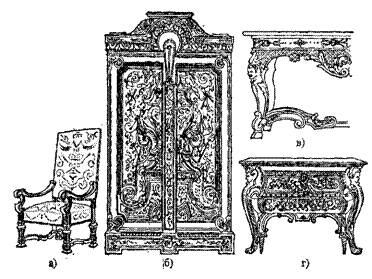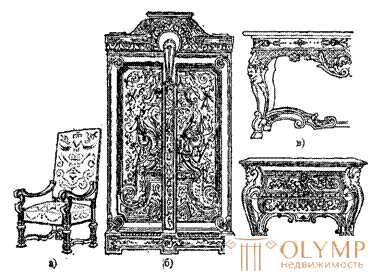
К середине XVII в. во Франции укрепляется абсолютная власть монарха. Колоссальные масштабы приобретает дворцовое строительство, вершиной которого является создание загородной королевской резиденции в Версале. Версаль станбвится не только предметом восхищения, но и объектом для многочисленных подражаний при строительстве резиденций других европейских королей, князей и герцогов. Ансамбль Версаля состоял из монументального дворца, садов, бассейнов и фонтанов. Композиция ансамбля подчинена строгому придворному этикету. Возглавляли создание ансамбля Версаля архитекторы Л. Лево и Ж. А. Мансар.
В планировке Версальского дворца главенствует анфиладный принцип (соединение помещений друг с другом через дверные проемы, расположенные на одной прямой), который с наибольшей силой проявляется в решении зеркальной галереи Мансара. Галерея по существу становится как бы проспектом, достигающим 73 м длины и перекрытым огромным коробовым сводом. Громадные составные зеркала придают залу особую роскошь. В систему анфилады включена королевская спальня, где ложе короля отделено низкой балюстрадой от текущего мимо потока придворных. Отделка парадных залов Версаля необычайно роскошна.
Стены, разбитые на отдельные панно, облицованы многоцветным мрамором и украшены колоннами и пилястрами, между которыми размещены лепные золоченые композиции. Фризы, карнизы и плафоны расписаны лучшими мастерами Франции.
В покоях, не отделанных мрамором, стены затянуты дорогими тканями, которые менялись в зависимости от времени года: зимой — зеленым или темно-красным бархатом с золотым галуном; летом — парчой с золотым или серебряным узором и многоцветным шелком.
Мебели в залах было немного: табуреты и несколько столов с вазами. Размещали ее строго вдоль стен.
Для этого периода характерно наличие двух разных техник выполнения мебели. Корпусную мебель отделывают древесным шпоном с последующим декорированием поверхностей различного рода инкрустациями и накладными металлическими деталями, а столы, кресла и табуреты не фанеруют, а золотят.
В этот период создают такие формы корпусной мебели, как футляры со стоячими часами и первые бюро, так в XVII в. стали называть письменные столы, крышку которых обклеивали сукном (bure, франц. — толстое сукно). Такие бюро имеют под крышкой два небольших выдвижных ящика. Выполняют бюро из черного дерева и украшают золоченой чеканкой бронзой на углах, ножках и ящиках.

Рис. 1. Мебель французского барокко (эпоха Людовика XIV): а — кресло, б—шкаф работы Буля, в — консоль, г — комод
Основное место в убранстве дворцовых помещений принадлежит кабинетам, которые также большей частью выполняют из черного дерева. Их опоры представляют собой группы колонн или кариатиды. Створки, обильно украшенные, скрывают ряды богато отделанных выдвижных ящиков и особый внутренний портал, напоминавший театральную сцену с декорациями. Лицевую часть кабинета решают как фасад барочного здания с выступами, карнизами, балюстрадой и фронтоном.
Кресла (рис. 1, а) обивают декоративной тканью. Ножки в форме четырехгранных балясин как бы набраны из нескольких квадратных и пирамидальных элементов, каждый из которых декорирован. Горизонтальные связи под сиденьем сильно изогнуты, криволинейные участки чередуются с прямолинейными.
Кресла, диваны, стулья в эту эпоху имеют обычно очень высокие спинки, заканчивающиеся выше головы сидящего. Ножки бывают пирамидальные (вершиной вниз), украшенные профилировкой, или в виде изогнутых наподобие буквы S завитков, концы которых украшены акантовыми листьями. В креслах для стариков с боков спинки появляются два полукруглых выступа, в обиход входит шезлонг—кресло с сильно отогнутой спинкой и удлиненным сиденьем для вытянутых ног.
Диваны как бы соединены из трех поставленных рядом кресел, благодаря чему образуется одна общая плоскость сиденья и спинки, которые обивают богатой декоративной тканью ярких тонов, изготовляемой на королевских мануфактурах Гобеленов, Бовэ и Обюссонов.
Столам придают круглую или прямоугольную форму. Ножки вертикальные, богато инкрустированы и вверху украшены бронзовыми женскими головками с удлиненным овалом лица и пышной прической, переходящей в завитки орнамента. Позднее ножки на узких концах стола обрабатывают в виде лиры, как у итальянских столов. Подзор и края столовой доски украшают богатой резьбой и инкрустацией.
В этот период во Франции работают многие прославленные мебельные мастера, но самым известным был Андре Шарль Буль (1642—1732), фламандец по происхождению, прославившийся искусством инкрустации.
Буль создал массивные шкафы (рис. 1, б), столы, комоды, стоячие часы, фанерованные черным деревом и украшенные своеобразным орнаментом. Тончайшие барочные узоры, завитки и листья, вырезанные из меди, олова, иногда из серебра, выделяются на фоне пластинок из полированного панциря черепахи. Решение мебели дополняется крупными украшениями из отлично прочеканенной бронзы. Иногда наоборот — узор из черепахи и олова вьется по медной доске. Часто Буль в центре орнамента помещал роскошные вазы с порхающими вокруг бабочками, набранные из цветного дерева.
Буль применял следующую технику: две тонкие пластины— черепаховую и медную — слегка склеивают друг с другом, на одну из них наносят узор, который одновременно сквозь обе пластины пропиливают лобзи-ковой пилой, пока узор не выпадет из них. Затем медный узор вкладывают в черепаховый фон и наоборот. В результате получают тройной эффект: тончайшую пригонку частей друг к другу, возможность одновременно создавать два предмета и, наконец, полное отсутствие отходов, что весьма важно при использовании ценного материала. Черепаховая доска с медным узором именуется первой партией, медная с черепаховым узором — второй, или контрпартией. При наличии в узоре олова пропилка велась через три доски.
Развитием этой техники была техника «пике», когда золотая нить вкалывалась в черепаховую пластину, затем отпиливалась, а поверхность полировалась. Рисунок получался точками.
Начинают широко применять декоративные консольные столы (рис. 1, з) на двух ножках, размещаемые под зеркалом. Резное подстолье консоли сплошь покрыто золоченой фигурной резьбой. Причудливо изогнутые ножки подстолья внизу скреплены проногой. Середину ее обычно украшал массивный резной картуш с королевским шифром или гербом.
У балдахина кровати не было вертикальных опор.
Около 1700 г. появляются новые типы мебели: комоды с выдвижными ящиками (рис. 1, г), письменные столы и постаменты для скульптур.
К середине XVII в. ведущая роль в искусстве мебели от Италии переходит к Франции. Французское влияние усиливается и в других странах, чему способствует высокий художественный уровень французской мебели. Свобода композиции, обильная декорировка сдерживаются и уравновешиваются ясностью и разумностью форм, предвосхищающих классическое искусство,
Что бы оставить комментарий войдите
Комментарии (0)